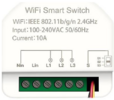The "California" system is a highly dangerous contraption that only works with DC-rated switches, in Germany it's known as a Hamburg 2-way circuit. Connect line and neutral to L1 and L2 of both switches and one wire from each COM to the light. Depending on the position of the switches, the light gets either N+N (off), L+N (on) or L+L (off). That means both poles of the light socket(s) can be live even though the light is off, which is quite dangerous with Edison sockets. Apart from that, rocker switches don't have enough of a contact gap to safely break an arc before it turns into a full short in this setup, so they usually burn out fairly quickly if someone replaces the ancient rotary or toggle switches with new rockers.
Some places in Germany loved the Hamburg circuit because in a TN-C system you could have a 2-way light switch and an earthed socket on a 3-core cable.
Some places in Germany loved the Hamburg circuit because in a TN-C system you could have a 2-way light switch and an earthed socket on a 3-core cable.



